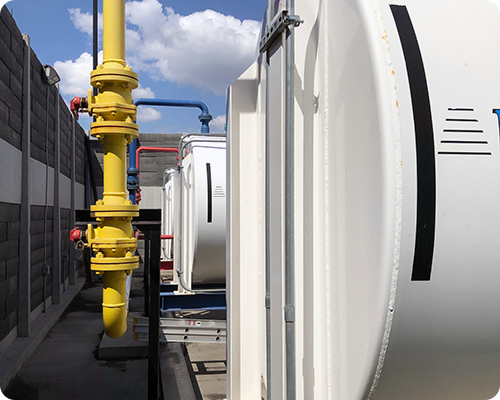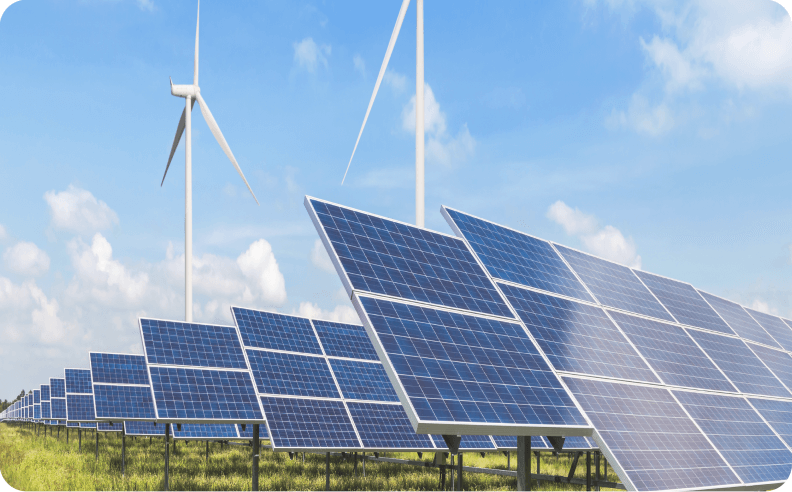Learn more about
Our environment
In preparing this webpage, we have considered the information available until March 7, 2024.
As Canada’s largest communications companyfootnote 1, we strive to create an environmentally sustainable future through responsible management of environmental impacts and mitigating the effects of climate change. Our stakeholders expect that our environmental focus be defined by purposeful action, so we are making progress toward optimal resource use by advancing our circular economy model and by seeking to reduce our GHG footprint.
Air emissions
Halocarbon releases
As an integral part of our operations, Bell uses specific chemical compounds, known as halocarbons. These halocarbons occur as refrigerants in air-conditioning and refrigeration systems and as fire suppressants in fire extinguishing systems. Common types of halocarbons, include hydrochlorofluorocarbons (HCFCs) and hydrofluorocarbons (HFCs). These chemicals contribute to global warming and ozone depletion when released into the atmosphere.
Due to the risk halocarbons pose to the environment, halocarbons release reporting and disposal are regulated federally and provincially in Canada. These regulations also aim to progressively eliminate the use of HCFCs and HFCs. Bell's long-standing focus on responsibly managing halocarbons in accordance with these regulations has resulted in many actions undertaken over the past 10 years, including:
- Implementing a reporting process in the event of a halocarbon leak;
- Developing and continuously executing HCFC and HFC usage phase-out plans;
- Replacing air-conditioning and refrigeration systems in a responsible manner, and when possible, with systems that use alternatives to halocarbon;
- Helping develop an air-conditioning system that uses compressed CO2 as a refrigerant.
Even with preventive and routine maintenance of systems, the release of halocarbons can occur due to mechanical defects and breakdowns. In 2023, the number of halocarbon leaks at Bell increased by 6% compared to 2022. Total leaks from air-conditioning and fire-extinguishing systems represented 5197 kg of halocarbons, which is a 14% decrease from the volume leaked in 2022. To further reduce leaks and control any future impacts, we perform root-cause analyses of incidents and equipment life cycle analysis.
Other emissions
Bell uses generators to support our remote operations as well as the delivery of continued service in the event of power failures. Our generators are powered by either diesel, gasoline, propane or natural gas. Consequently, generators produce air emissions, including carbon monoxide (CO), nitrogen oxides (NOX), sulfur oxides (SOX), volatile organic compounds (VOC), particulate matter (PM) and total particulate matter (TPM). Bell uses Tier 4 generators whenever possible that conform to the cleanest air emission standardsfootnote 2.
Although we don't track all of our air emissions, we do track CO, NOX, SOX, VOC, PM and TPM emissions at our largest sites. We also measure air emissions at these facilities whenever a change in operations occurs that could affect emission levels. Since 2012, year-over-year results from these facilities indicate that our emissions are all below the National Pollutant Release Inventory's thresholdsfootnote 3.
In addition, Bell uses powerful equipment to support its operations. Even the newest and most advanced machines can produce noise. We seek to limit our noise emissions by assessing and correcting elevated acoustic levels when equipment near a sensitive element or in a sensitive area is installed, modified or replaced, and when a noise complaint is reported to us.
Soil and water protection
Bell's network infrastructure spans across Canada and requires various indoor and outdoor equipment to support communication services. If not properly managed, equipment and network maintenance activities may impact the surrounding area, including by unintentionally introducing contaminants into the environment.

Bell owns or leases many buildings to facilitate administrative activities, support network infrastructure and maintain service delivery. Related human activities and equipment installed in buildings contribute to the consumption of resources, including water.
We have developed programs that seek to responsibly manage our petroleum equipment, contaminated properties, waste water from manholes, and treated wood poles, with the objective of minimizing or avoiding the release of contaminants to land or water, and efficiently managing the resource consumption generated by our activities.
Petroleum products equipment management
Our storage tanks may be above ground or underground. Above ground tanks are easier to secure and inspect and are preferred for tank installation and replacement projects. Our standard of care for tanks generally surpasses the regulatory requirements of federal, provincial and U.S. state regulations (in the 6 states where Bell operates) that govern the installation, operation and removal of petroleum storage tanks.
94% of Bell's approximately 3,700 petroleum storage tanks are above ground. We manage and monitor our petroleum storage tanks and equipment to seek to maintain their integrity and prevent accidental spills. We perform annual inspections on every tank and conduct compliance audits as required by regulations. Our plan for managing our equipment also includes:
- Reducing (or optimizing) the number of tanks and minimizing the installation of underground tanks;
- Replacing single-walled above ground tanks (with a capacity above 4,000 litres and located outside of buildings) with double-walled tanks;
- Rigorously following our equipment inspection program;
- Executing a multi-year plan to replace or upgrade tanks based on priority and a risk analysis.
We have also installed leak alarms on petroleum equipment at key and critical sites and connected them to a centralized control centre for 24-hour monitoring.
Environmental site assessments
To serve Canadians across the country, Bell owns and leases numerous properties including administrative offices, central offices, work centres, switching centres, transmission towers and warehouses. These properties may have historical contamination (attributable to Bell or third parties), or may become contaminated by Bell's operations or by contaminants migrating from surrounding properties. Bell's operations may cause contamination, such as from accidental releases of petroleum hydrocarbons and by leaching from treated wood utility poles.
Bell conducts environmental site assessments to seek to minimize the environmental risk associated with contaminated soil and groundwater. Bell performs site assessments when terminating an operational activity that has potential to cause contamination, when there is a discovery of historical contamination or a large spill of contaminants, and for most real estate transaction (purchase, sale, lease or lease termination).
When required by regulations or when otherwise considered appropriate, remediation of soil and/or groundwater is conducted. The criteria for remediation are based on territorial, provincial and federal regulations.
Our property assessment program is driven by the following objectives:
- Take the necessary measures to minimize the impacts to the natural environment in the event of a spill/release or discovered contamination;
- Establish and maintain an efficient due diligence process to minimize Bell's environmental and financial liabilities associated with soil and groundwater contamination caused by previous land users;
- Seek to prevent any future legal action associated with known contamination when leasing or selling a property.
Waste water from manholes
A considerable portion of Bell's network is located in underground conduit structures that are accessible by manholes. Underground and above-ground manhole entry points allow for effluent to migrate into them, and also allow for the possibility of contaminant migration. When Bell's underground network needs to be accessed for installation, maintenance, repair or decommissioning, the effluent that has accumulated in manholes must be pumped out in order for technicians to safely conduct their work. To seek to ensure that contaminated effluent is not pumped outside of a Bell manhole, technicians are required to follow the company's environmental pumping procedure.
Adherence to this procedure seeks to ensure that contaminated effluent is identified before the manhole is pumped, thereby protecting surrounding land and water bodies from these contaminants.
When water in a manhole is identified as being contaminated, a specialized company is engaged to safely pump and dispose of the contaminated effluent in a way that safeguards the environment. In the event contaminated water is inadvertently pumped into the environment, Bell seeks to promptly intervene and complete remediation.
Treated wood poles
A considerable portion of Bell's network is aerial, supported by approximately 1.5 million wood poles. The majority of Bell's poles are treated with preservatives to extend their useful life and to help them withstand the natural elements. These preservatives can be toxic to lifeforms if conditions permit the preservatives to leach or otherwise be released into the environment.
Seeking to ensure that soil and water are not impacted by these preservatives, Bell adheres to pole installation criteria that take land slope, soil type, proximity to water bodies and other sensitive areas into consideration. We usually opt for untreated cedar poles when the environmental risks of using treated wood poles are increased.
In addition to managing poles in the network, Bell stores new and used poles in storage yards. This facilitates aerial network installation, maintenance, repair and decommissioning activities. It is important that these poles are stored in a way that safeguards surrounding soil and water.
Bell poles that are not in use are stored in company-approved yards, built and maintained in accordance with industry best practices and the company's internal environmental procedure aimed at ensuring that all treated wood poles under Bell's administration are managed in a way that protects the environment.
Lead cables
Bell’s overall wireline infrastructure still contains a very small percentage of lead-sheathed cables, Bell transitioned away from installing such cables in the 1960s when we began deploying plastic polymers in place of lead for the majority of our cable deployment. Since the mid-2000s, Bell has also been replacing lead-sheathed copper cables with fibre. As we upgrade our network from copper to pure fibre, we have been removing lead-containing components in active construction areas where feasible and safe to do so in line with established safe handling protocols.
Water consumption
In our industry, the majority of water usage relates to the manufacturing of electronic components by suppliers, rather than the day-to-day operational delivery of communication services. Bell acknowledges that the availability of water is a growing concern in many communities around the world and that many of our suppliers face water stress, which can affect the availability of electronic components.
Bell's direct activities only have a minor impact on water resources, as we mainly use water for drinking and sanitary purposes, vehicle cleaning and cooling buildings and server rooms. This does not deter us from implementing programs and practices to control our water consumption.
Our water consumption reporting is based on a methodology that includes three sources of data (i) water meters, ii) estimation based on water-use intensity ratios and iii) utility bills), along with six site categorizations by primary water consumption type and intensity (e.g., equipment cooling, kitchen and domestic use). Together, these three data sources and six site categorizations permit us to estimate the volume of water that our operations use every year.
Sustainable real estate
In keeping with our objective to continually improve our sustainable practices, Bell has developed an integrated sustainable real estate vision that addresses building activities (and other infrastructure) that have a potential impact on the environment.
Buildings
As part of our vision, which extends beyond compliance with regulatory standards, we work with the BOMA BEST (Building Owners and Managers Association's Building Environmental Standards) and LEED (Leadership in Energy and Environmental Design) building certifications, which are central to seeking to ensure that environmental impacts are considered.

Bell operates in 9 buildings with BOMA BEST certification, which include BOMA BEST Gold or Platinum certification level. Bell also operates in 7 buildings with LEED certification, as detailed in our ESG Data Summary.
We seek to achieve and maintain high standards for sustainable buildings through the implementation of sustainability initiatives in certain areas of the company’s real estate portfolio, including the following:
|
Sustainable building aspect
|
Features and benefits
|
|---|---|
| Energy efficiency |
|
| Waste reduction |
|
| Sustainable construction materials or design |
|
| Exterior biodiversity |
|
| Efficient water use |
|
| Interior greening |
|
| Ecologically-friendly maintenance |
|
| Sustainable transport |
|
We expect to continue implementing sustainability features to help reduce the impacts of our buildings on the environment.
Street furniture
In addition to maintaining a range of certifications for our buildings, Bell strives to limit the environmental impacts of street furniture deployed throughout Canadian cities, including Toronto. In this city alone, more than 4,600 of our bus shelters and 2,200 of our benches have been designed to promote the use of recycled materials and FSC-certified wood. The use of recycled materials promotes a circular economy, whereas the use of FSC-certified wood promotes responsible forest management. Additionally, when planning, modular design is preferred for street furniture as it is easily replaceable (replacement of only the damaged parts) and greatly reduces the volume of waste generated. An eco-friendly maintenance program that limits the use of chemicals complements these sustainable attributes. In addition, the upstream selection of materials that are easy to clean allows for the quick removal of graffiti and vandalism markings, whilst reducing the waste generated by the replacement of damaged parts.
Biodiversity and ecosystems
The majority of network infrastructure that powers Bell's services is located outdoors, whether aerially, underground or underwater. Bell teams work outside in the natural environment every day to install, maintain, repair and decommission network infrastructure. These activities can have a potentially negative impact on the natural and human environment.
To seek to protect biodiversity and Canadian ecosystems, Bell has developed a Biodiversity and ecosystem interference program that governs network projects and manages its interference with natural habitats and environmentally sensitive areas. We pay special attention to mitigating biosphere integrity degradation and land-system change impacts by studying each network project and assessing the potential environmental impacts.

Network impacts
Bell's telecommunication network infrastructure is deployed across different territories. Minimizing harm to wildlife, vegetation, water and soil is a key consideration taken into account at every stage of a network project, including planning, design, construction, maintenance and decommissioning of installations. Among other matters, we:
- Conduct environmental assessments;
- Obtain applicable work permits and authorizations and strive to comply with them;
- Seek to mitigate environmental impacts;
- Strive to comply with air and noise emission limits.
Tree management
Bell strives to protect Canadian wildlife in a number of ways, as our network infrastructure interacts directly with the natural environment. Our tree management practices, that need to be followed by all network employees and contractors, include taking steps to minimize tree trimming, cutting and clearing during network deployment, while maintaining network integrity. In the interest of protecting biodiversity, employees are educated about how and when trees can be pruned and how wood residues should be handled.
In 2022, Bell launched a new partnership with Tree Canada, a national non-profit organization dedicated to planting and nurturing trees in rural and urban environments, to celebrate National Tree Day. Bell employees participated in the past two National Tree Days to help plant trees across Canada. Bell is excited to continue initiating and participating in tree planting activities across the country and contributing to Canada's 2 Billion Trees Program (2BT)footnote 6.
Pest management
It is important for the integrity of Bell’s network as well as the safety of employees and community members that Bell controls the proliferation of vegetation, insects and small animals that can pose a risk to our networks, employees and community.
Except in emergency situations, Bell requires that physical and mechanical methods be prioritized over any other methods to control the spread of pests. Bell permits the use of pesticides in extenuating circumstances and/or only once physical and mechanical methods have proven to be unsuccessful.
In 2023, Bell participated in the “No-Mow May” initiative. The idea behind No-Mow May is to let grass grow for the whole month to allow pollinators access to temporary habitats and food sources until summer plants grow. Bell employees were encouraged to do the same at home. Bell will seek to extend annually the number of facilities participating in the initiative across the country to contribute to biodiversity protection.
Environmental incidents management
At Bell, we have processes in place to manage environmental incidents and act diligently on the root cause of problems to prevent future reoccurrence. We strive to increase employees' awareness on preventing environmental incidents and on the importance of reporting them. Bell has developed measures to deal with environmental incidents. These specify the steps employees must follow and the responsibilities of the different parties involved in order to adequately respond to an environmental emergency.
We aim to address all incidents diligently and in compliance with all regulatory requirements to limit the impact on the environment.
Footnotes
1 Based on total revenue and total combined customer connections.
2 Based on Government of Canada’s guidance document providing information about the requirements of the Off-Road Compression-Ignition Engine Emission Regulations.
3 The NPRI is Canada’s public inventory of releases, disposals and transfers of pollutants from facilities across Canada.
4 Based on the Guidance for the Industrial Treated Wood User Concepts to include in an Environmental Management System published by Environment Canada.
5 Water use intensity ratios, based on measured water consumption for similar work spaces, have been developed for each type of work space we occupy. For occupied space without measured water consumption, we apply the appropriate intensity ratio to the area (sq. ft) of occupied space to estimate the related water consumption.
6 The 2BT is a Government of Canada program aiming to provide financial support to organizations to plant 2 billion trees over 10 years (2021-2031) in the country.

